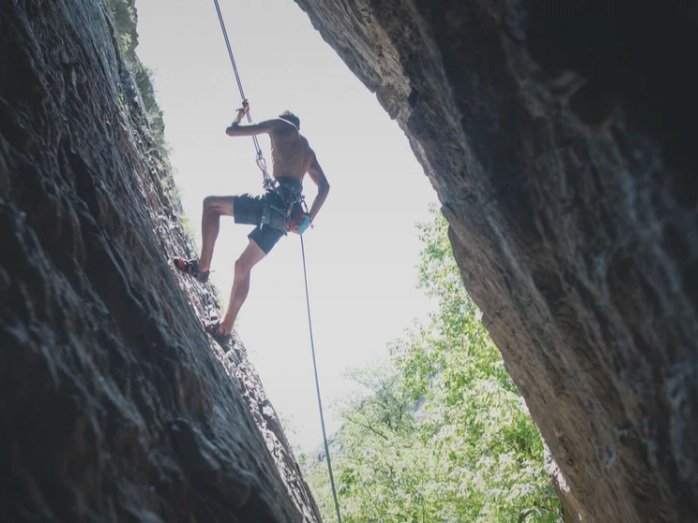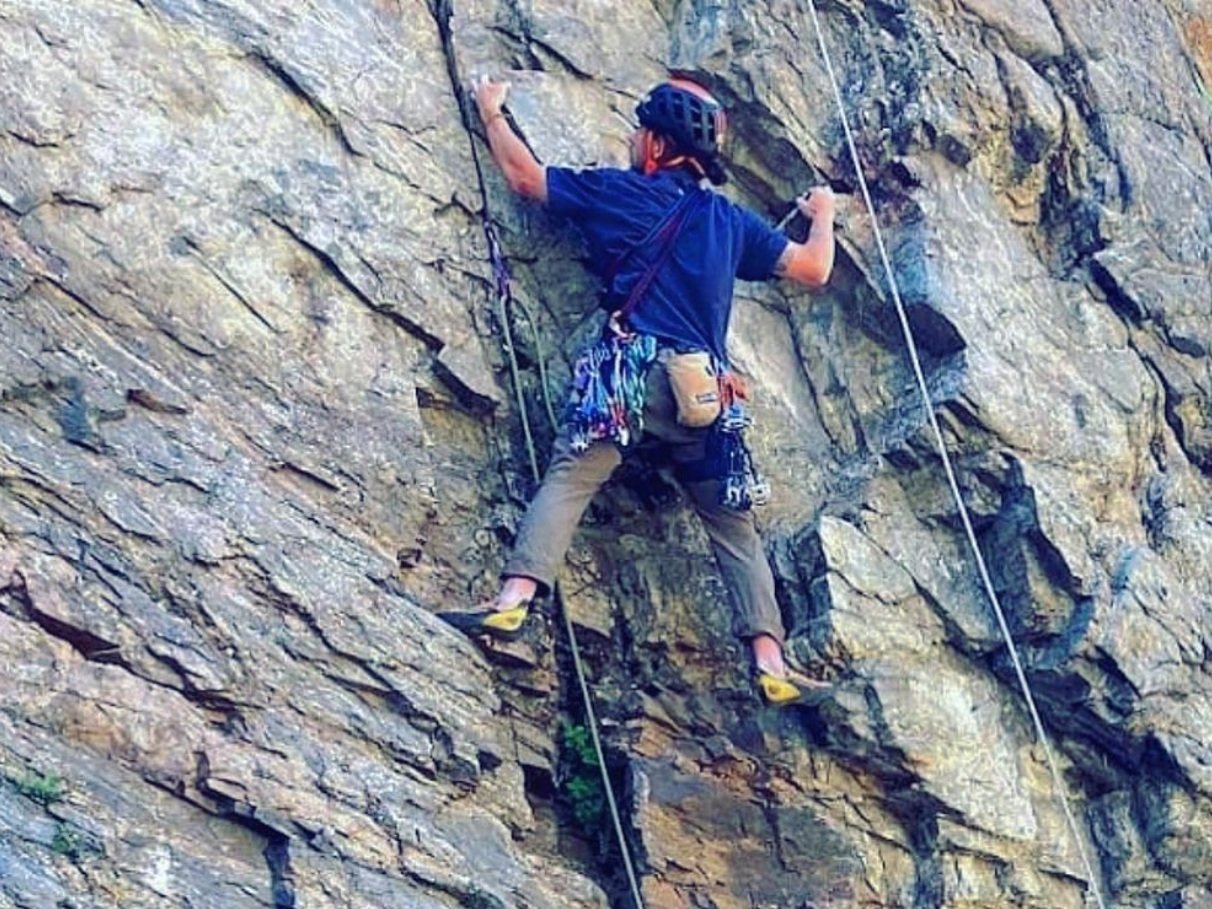Why We Climb
Rock climbing is a powerful activity that brings us into immediate presence. Climbing challenges us physically, mentally, and spiritually and teaches us coping skills that we can apply in any situation. When we climb, the opportunity to develop and practice various hard and soft skills is applied in the moment. These skills traverse outdoor adventure proficiencies as well as emotional awareness, requiring us to observe and make impactful decisions in real time. Ironically, in order to excel in climbing, we need to be grounded—rooted in a foundation of calm within. Being grounded is about being able to respond rationally, pragmatically, and peacefully to situations which may be high stress. Rock climbing positively impacts our mental health by training the mind and body to create positive resilience loops. There are multiple techniques that can be utilized to help someone ground and land in their bodies in the present moment. Learning these skills increases our capacity. But that’s not the only reason we climb.
The Reasons We Climb
There are many reasons why we climb (and boulder). For some, setting goals and then reaching them is ultimate satisfaction and drives one to continue to evolve and strive. Others may be more drawn to the process of working through challenges and establishing solutions, pushing through fear and doubts. Either way, the work of learning not only the technical skills but how to find composure in stressful situations are powerful tools that apply to every area of life.
Many of us take risks as children and teens. We may seek excitement or an adrenaline rush, through the release of happy hormones. It’s a natural part of being human to seek challenge and feelings of exhilaration, elation, and awe. What’s more, sometimes the way we seek these experiences is not healthy. Perhaps we ingest substances or drive too fast; some of us may have engaged in illegal activities. You get the idea. What some seek is the empowering feeling of simply being alive and part of something bigger than ourselves. The behaviors often have consequences, many of which may be unpleasant and unhealthy. Now, we seek the same feelings but through life-affirming, skills-based methods that have clear protocols for safety and precision.
The Science of Rock Climbing and Mental Health
Getting out on the rock is more than just fun, it’s therapeutic. The research demonstrates clearly that climbing and bouldering are highly impactful interventions in mental health and substance use disorder. In particular, one study revealed that bouldering can reduce symptoms of depression. When we combine the task of bouldering or climbing with the beauty of time in nature, the positive side effects are increased. However, even indoor climbing had a clear affect on people struggling with depressive traits. A recent study from 2021 followed individuals engaged in climbing as it related to the amelioration of stress as well as the application of mindfulness and capacity. During the study fifty-nine participants were measured in terms of mindfulness, wellbeing, and anxiety before and after participating in an ‘intervention’. The intervention consisted of a mindfulness activity followed by bouldering versus a physical activity control. Despite limitations, the experiment:
“…provides evidence that rock-climbing has practical implications within positive psychology and mental health. Firstly, it adds to the existing literature in support of physical activity to increase wellbeing in young adults; and secondly, it provides the first evidence that bouldering can effectively increase mindfulness in a healthy sample of young adults. This is the first study to experimentally demonstrate that engagement with rock-climbing increases mindfulness in young adults. Theoretically, the results have implications for our understanding of “flow” and optimal human experience. Practically, the study highlights the potential to implement rock-climbing as a resilience-building activity and integrate the sport within therapeutic frameworks.”—Katherine A. Wheatly, Study Author, Nottingham Climbing Centre, University of Nottingham, Nottingham, UK
Self-Regulation and Grounding Techniques
Learning how to manage physiology in various settings is hugely empowering. This is especially true when it comes to mental health. There are tried and true methods for coming into harmony with our bodies and mitigating feelings of anxiety and stress. In states of panic, our bodies will naturally want to go into the fetal position, our chest compressed, and we may feel general tightness. In addition to this, the mind may go south for the winter, so to speak. When we are activated or in a heightened state, i.e.: fear, anxiety, panic – the brain may start to feel agitated, with cyclical thoughts—our mind is gone. We are no longer capable of functioning in an optimal manner in this state. Hence, we must calm the mind. By opening the chest, head up, arms spread, taking the breath into the belly, we can trigger our parasympathetic nervous system to relax. We can also take a moment and slowly scan the horizon, moving the head at an even pace, allowing any panic or anxiety to subside. The idea is to slow down. Perhaps we pause to look around, notice the overall beauty and awe of the sport. We can que intentional breathing by applying rhythmic breath awareness, as simply as counting to four on the inhale, four on the exhale, and gently bring the mind back. These methods are also ways for us to find a sense of composure in stressful moments in life.
Rock Climbing + Mental Health: Self-Mastery
When we start to master ourselves, we can excel. This is part of why climbing is such a powerful intervention in mental health and substance use struggles. We’re learning to problem-solve in real time. In addition, we are increasing self-esteem by rising to challenges and through achievement.
“I found climbing in early recovery. I would go to the gym with my brother on the weekends. It was my escape, or so I thought. What I grew to understand was that it wasn’t an escape. It was an experience that allowed me to connect deeper to myself. The practice was to be in my breath, to focus on my movement, to cope with my stresses, and learn how to not let them affect every fiber of my being. I could breathe and move freely despite anything going on. I began to climb more regularly, becoming stronger, more apt, wanting to test myself on larger challenges. Climbing has given me so much more than a sport. It has given me the lifelong connection with teachers, the opportunity to be a teacher and to learn, firsthand, about overcoming adversity through triumph. I will forever be grateful for this sport and am so thankful my life revolves around sharing it with those who are open to the same experience.”—Nate Bennick, AR National Field Director
Back to the Body: Identifying your Senses
When climbing, we willingly place ourselves in a stress-induced situation. Learning how to keep oneself present and aware allows us to reach deep within and find great sources of power. We often ask our clients to identify what is around them and have them describe objective features that will bring them into their tactile and visual senses, into their body. Paired with their breath, they will be able to shift their focus from their fear to a solution-driven mindset.
Often, we embark on challenges we may not be sure we can accomplish. How often have we been too afraid to try something new, to reach for new heights, to speak up when we knew something was wrong, to change? Climbing gives us the opportunity to push our understanding of our stress tolerance and build deeper resilience, capacity, and strength. More importantly, before entering any endeavor, we ask ourselves what skills do I have to offer this challenge? What tools do I have? Can I picture myself using them to succeed? Take a few moments and find a problem you are working on. Think about what you can do to accomplish it. Now visualize yourself doing it.
Rock Climbing and Accepting Fear
Embracing Fear is a concept many of us are not familiar with. By choosing to do things that scare us, that push our comfort zone, challenge us to find our courage, we can grow. Sometimes, we choose not to look at our fears. What happens when allow the fear and do it anyway? We learn that our fear is a part of us, that it is there to protect us. How do we listen and give space for it without letting it dominate our decisions and actions? How do we love that part of who we are and remind ourselves that our power still exists, even in fear? This is the work for a lot of us and it is always worth it.
“Climbing to me feels like a dance, and though it is often marked by moments of fear, I feel the support of my partner belaying me below, and I can focus on the deliberate movements to carry me up the wall. There is nothing more rewarding than reaching the top of the climb and knowing that you had the strength and the perseverance to get to the top.”—Katelyn Green, AR Field Supervisor and Lead Guide
The Power of Choice
Breathe. Remember, you always have the option to do something. Or not. You get to choose. We always have the choice of how we look at our situation. If there are action steps available, what holds us back from taking them? Only ourselves.
What inspires you to climb? For some it’s physical exercise, for others it is a form of meditation. Throughout the growth process, it is easy for the ego to pop its head out and team up with what we call the “You Suck Monster”. If we are chasing grades or pursuing our objectives to feel external validation, it will never feel complete.
Learning Trust While Climbing
In addition to needing to know our motives, it’s important that we know how to trust, ourselves, our belayer, or the rock itself. Since our minds can be powerful in determining performance, this is an important aspect of climbing and embarking from a solid disposition. Composure is found when we surrender fears and ascend with courage. One hold at a time, we find the most beneficial form of trust—within. Self-trust is something many of us are not as familiar with in our awareness but it is the route to healing. Climbing for mental health builds this self-reliance and self-trust.
“Climbing builds trust. It requires trust in the wall, the rocks that have stood there for generations, it requires trust in the ropes, and requires trust in the belayer, the person whom you have entered a brief, yet unbreakable contract with to trust with your life. I value the metaphors that climbing provides through this level of trust. The climber and the belayer are physically connected at either end of the rope, and yet that connection extends beyond just the physical. The belayer is there to support, to guide, and to reassure, and because of this, the climber has the confidence to make it up the wall. This is a metaphor that I carry into my daily life. Without the support of my family and friends in my struggles with depression, anxiety, and suicidal ideation—much like the support of the belayer, myself as the climber—I would not have the strength I needed to scale my own inner mountains and obstacles.”—Katelyn Green, AR Field Supervisor and Lead Guide
If you’re new to climbing, please be sure that you seek a qualified guide to lead you. You’ll never regret the instruction; it only makes you a better athlete, and for us, a better human being. Being teachable is a big part of rock climbing.
Climb on.








